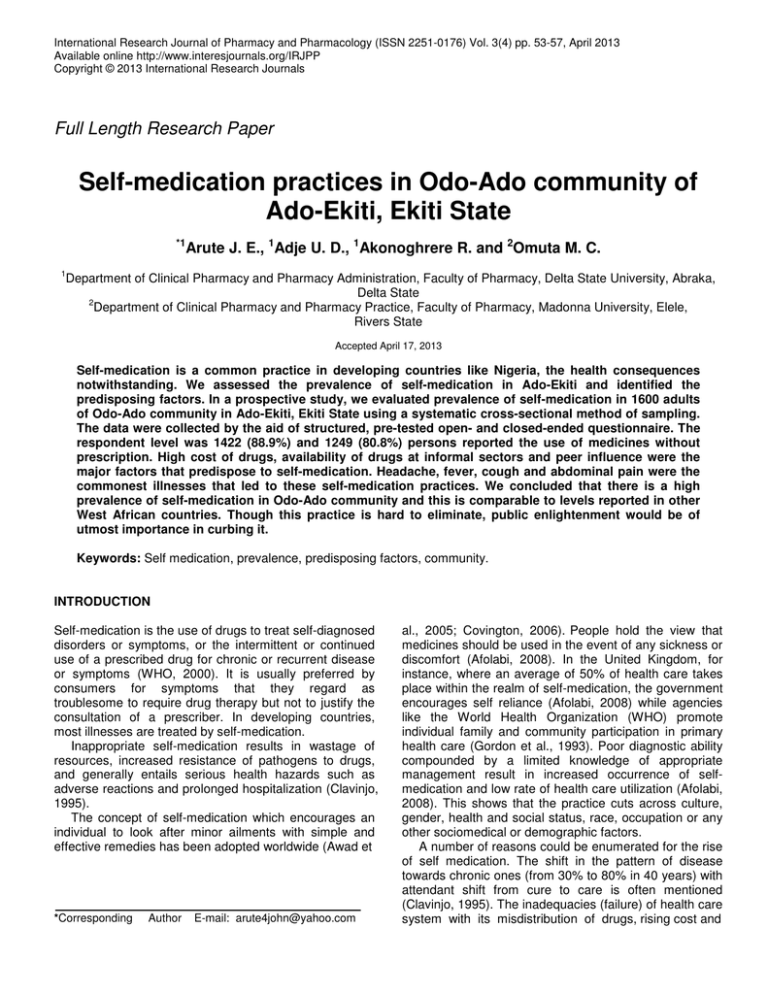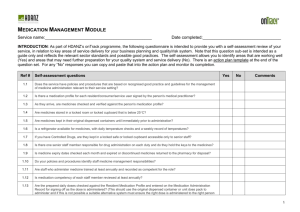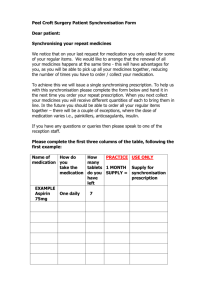Document 14262911
advertisement

International Research Journal of Pharmacy and Pharmacology (ISSN 2251-0176) Vol. 3(4) pp. 53-57, April 2013 Available online http://www.interesjournals.org/IRJPP Copyright © 2013 International Research Journals Full Length Research Paper Self-medication practices in Odo-Ado community of Ado-Ekiti, Ekiti State *1 Arute J. E., 1Adje U. D., 1Akonoghrere R. and 2Omuta M. C. 1 Department of Clinical Pharmacy and Pharmacy Administration, Faculty of Pharmacy, Delta State University, Abraka, Delta State 2 Department of Clinical Pharmacy and Pharmacy Practice, Faculty of Pharmacy, Madonna University, Elele, Rivers State Accepted April 17, 2013 Self-medication is a common practice in developing countries like Nigeria, the health consequences notwithstanding. We assessed the prevalence of self-medication in Ado-Ekiti and identified the predisposing factors. In a prospective study, we evaluated prevalence of self-medication in 1600 adults of Odo-Ado community in Ado-Ekiti, Ekiti State using a systematic cross-sectional method of sampling. The data were collected by the aid of structured, pre-tested open- and closed-ended questionnaire. The respondent level was 1422 (88.9%) and 1249 (80.8%) persons reported the use of medicines without prescription. High cost of drugs, availability of drugs at informal sectors and peer influence were the major factors that predispose to self-medication. Headache, fever, cough and abdominal pain were the commonest illnesses that led to these self-medication practices. We concluded that there is a high prevalence of self-medication in Odo-Ado community and this is comparable to levels reported in other West African countries. Though this practice is hard to eliminate, public enlightenment would be of utmost importance in curbing it. Keywords: Self medication, prevalence, predisposing factors, community. INTRODUCTION Self-medication is the use of drugs to treat self-diagnosed disorders or symptoms, or the intermittent or continued use of a prescribed drug for chronic or recurrent disease or symptoms (WHO, 2000). It is usually preferred by consumers for symptoms that they regard as troublesome to require drug therapy but not to justify the consultation of a prescriber. In developing countries, most illnesses are treated by self-medication. Inappropriate self-medication results in wastage of resources, increased resistance of pathogens to drugs, and generally entails serious health hazards such as adverse reactions and prolonged hospitalization (Clavinjo, 1995). The concept of self-medication which encourages an individual to look after minor ailments with simple and effective remedies has been adopted worldwide (Awad et *Corresponding Author E-mail: arute4john@yahoo.com al., 2005; Covington, 2006). People hold the view that medicines should be used in the event of any sickness or discomfort (Afolabi, 2008). In the United Kingdom, for instance, where an average of 50% of health care takes place within the realm of self-medication, the government encourages self reliance (Afolabi, 2008) while agencies like the World Health Organization (WHO) promote individual family and community participation in primary health care (Gordon et al., 1993). Poor diagnostic ability compounded by a limited knowledge of appropriate management result in increased occurrence of selfmedication and low rate of health care utilization (Afolabi, 2008). This shows that the practice cuts across culture, gender, health and social status, race, occupation or any other sociomedical or demographic factors. A number of reasons could be enumerated for the rise of self medication. The shift in the pattern of disease towards chronic ones (from 30% to 80% in 40 years) with attendant shift from cure to care is often mentioned (Clavinjo, 1995). The inadequacies (failure) of health care system with its misdistribution of drugs, rising cost and 54 Int. Res. J. Pharm. Pharmacol. The issue of curative stance of drugs are worth mentioning (Clavinjo, 1995; Solomon and Abebe, 2003). Many resort to the practice of self-medication instead of contacting professional health care workers because of long waiting period in hospitals, minor ailment, cost, to save money and time, lack of accessibility, shortage of doctors or a feeling that their ailment is beyond the knowledge of western trained doctors (Niger State University, 2000). The use of drugs from informal sectors such as open markets, sale clerk in the chemist shop, and village kiosks encourage the practice of self- medication. In order to handle unnecessary health risk and bacterial resistance due to improperly obtained drugs, it is important to consider the manner of drugs availability to consumers (Yayehyirad, 1997). Though self-medication is difficult to eliminate, interventions can be made to discourage the rampant practice. The increasing self-medication will require enlightenement of both the public and health professionals to reduce irrational use of drugs. ended questionnaires were used to collect the data. The pretext was done on 5 households which were excluded from the study. Slight modifications were done to optimize the questionnaire usage. The collected variables include: socio-demographics (age, sex, gender, religion, education) and information on self medication such as health condition two months prior to the survey, action taken in response to illnesses, the sources of drugs used, and the reasons for self medication. Participants that required assistance had their questionnaires completed in the presences of the researcher. Data analysis and interpretation The data collected were entered into Microsoft Excel 2007 (Microsoft Inc, USA) and double checked for accuracy. Analysis was done using descriptive statistics (mean and percentages). RESULTS METHODS The study was carried out in Odo-Ado, one of the major communities in Ado-Ekiti, Ekiti-State, with a population of over 14,600 people according to 2006 National Population Census, majority of who belong to the Yoruba ethnic group. The average family size is about 4.0. The people of Odo-Ado community have relatively low access to health facilities. There are one general hospital, one health center, one clinic, 3 pharmacies, more than 20 patent proprietary and medicine stores, over 10 traditional healers, and other private and NGO clinics in Odo-Ado. Study design st This is a descriptive prospective study carried out from 1 st to 31 December, 2009. The survey included systematically selected households that were taken randomly. Everybody in the selected households was eligible for the study. From each of the selected households, individuals were contacted and the purpose of the research explained to them. Verbal and informed consent was granted before the administration of the questionnaires. Data collection Self-administered, structured pre-tested open and closed The age of the respondents ranged from 18 years and above, with an average age of 40 years.1037 (72.9%) were in the age group of 26 and above and 869 (61.1%) were females. 350 (31.7%) of the respondents were married. Majority of the respondents 1013 (71.3%) were literate, Christians represented 852 (59.8%) and Muslims 394 (27.7%). The majority, 1015 (71.4%) earns monthly income of between N5, 000 and N99, 000. (Table 1) Table 2 shows the prevalence of self medication practice, 1249 (80.8%) of the respondents practiced self-medication, out of which 724 (50.9%) reported use of pharmaceutical products only, 373 (26.3%) took herbal products and 650 (45.7%) took both pharmaceutical and herbal products two months prior to the study. Table 3 shows the reasons for self medication practices. 632(44.4%) and 513(36.1%) of the respondents reported that they used self-medication because of reduced cost and minor illnesses respectively. Table 4 shows that 416(29.2%) respondents reported that they obtained their medicines from hospital/pharmaceutical shops, while 773(54.4%) reported that they obtained their medicines from drug retail outlet and Table 5 shows the commonest illness for which the respondents took medicines, headache 1344 (94.5%) and fever 1085 (76.3%) being the most common. Arute et al. 55 Table 1. Frequency Distribution Characteristics of the Respondents. Demographic characteristics Age (years) 18-25 26-35 36-45 46-60 61 and above Sex Gender Single Married Divorced Separated Widowed Educational attainment No formal education Primary school Secondary school Tertiary school Above first degree Religion Christianity Muslim Traditional Others Average monthly income Less than 5,000 5,000-19,999 20,000-99,999 100,000-299,999 300,000 and above of Demographic Male (%) Female (%) 169 (11.9) 214 (15.0) 58 (4.1) 60 (4.2) 52 (3.7) 553 (38.9) 216 (15.2) 253 (17.8) 115 (8.1) 174 (12.2) 111 (7.8) 869 (61.1) 107 (7.5) 186 (13.1) 84 (6.0) 103 (7.2) 73 (5.1) 236 (16.6) 264 (18.6) 114 (8.0) 168 (11.8) 87 (6.1) 94 (6.6) 87 (6.1) 163 (11.5) 138 (9.7) 71 (5.0) 110 (7.7) 118 (8.3) 342 (24.1) 216 (15.2) 83 (5.8) 346 (24.3) 161 (11.3) 42 (3.0) 4 (0.3) 506 (35.6) 233 (16.4) 109 (7.6) 21 (1.5) 86 (6.1) 314 (22.1) 114 (8.0) 29 (2.0) 10 (0.7) 174 (12.2) 381 (26.8) 206 (14.5) 89 (6.3) 19 (1.3) Table 2. Prevalence of self-medication practice. Variables Medicines taken without doctor’s prescription Yes No Medicines taken in the last two month Pharmaceutical products Herbal products Stimulants All of the above None of the above Medicines used together on the same day Pharmaceutical products and herbal products Pharmaceutical products and stimulants Herbal products and stimulants All of the above None of the above Male (%) Female (%) 415 (29.2) 138 (9.7) 734 (51.6) 135 (9.5) 461(32.4) 248 (17.5) 227 (15.9) 641 (45.1) 0 (0) 1063 (74.8) 824 (57.9) 416 (29.3) 849 (59.7) 2 (0.1) 617 (43.4) 382 (26.9) 311 (21.9) 728 (51.2) 56 (3.9) 816 (57.4) 814 (57.3) 223 (15.7) 114 (80.8) 33 (2.3) 56 Int. Res. J. Pharm. Pharmacol. Table 3. Reasons for self-medication. Reasons for using self-medication Long awaiting period in the hospital Minor ailment Less cost Shortage of doctor Dissatisfaction with quality of medical care received Male (%) 83 (5.8) 307 (21.6) 139 (9.8) 3 (0.2) 21 (1.5) Female (%) 89 (6.3) 206 (14.5) 493 (34.6) 56 (3.9) 25 (1.8) Table 4. Sources of drugs for self-medication. Sources of drug used in self-medication Hospital/pharmaceutical shops Patent dealers/drug retail outlet Local hawkers/open market place Herbalist Others Male (%) 123 (8.6) 306 (21.5) 108 (7.6) 5 (0.4) 11 (0.8) Female (%) 293 (20.6) 467 (32.9) 60 (4.2) 16 (1.1) 33 (2.3) Table 5. Common illness reported for the use of medicines. Common illness for which medicines are taken Headache Fever Cough Abdominal pains Others DISCUSSION The result revealed a high prevalence of self-medication practice similar to findings in Latin American and Sudan (Awad et al., 2005; Drug Utilization Research Group, 1997). Majority of the participants fall within 26-35 years (32.8%) and the least fall within 61 years and above (6.8%). This probably showed that elderly people did not really practice self-medication but sought medical help. The females practiced self medication more than the males (57.3%) and this finding is in agreement with the study done in Mexico that identified women as the fundamental elements in the consumption of drugs and practice of self medication (Angeles, 1992). In this study, medicines, including herbs, were used by 80.8% of the respondents without medical diagnoses. Proprietary medicines alone were used by 50.9% of the respondents, herbs alone by 26.3%, while 45.7% had used both within two months prior to this study. The use of medications in combinations was low in the extremes of ages. This low prevalence among the elderly agrees with an earlier study (Afolabi, 2008; Angeles, 1992), while high prevalence among the younger age groups have been reported (Afolabi, 2008; Awad et al., 2005). Plausible explanation for the high rate of medications Male (%) 553 (38.9) 461 (32.4) 312 (21.9) 58 (4.1) 82 (5.8) Female (%) 791 (55.6) 624 (43.9) 312 (21.9) 686 (48.3) 103 (7.3) consumed in combination among the 26-35 year group might be due to the fact that these were the active groups and tend to have more health-related complaints like blood loss of menstruation, stress caused by daily market schedule and family problems. The commonest reason for the practice of self medication was because of its relative less cost (44.4%). As WHO noted, self medication provides a cheap alternative to people who cannot afford to pay medical practitioners. Thus, self medication is often the first response to illness among people with low-income (Drug Utilization Research Group, 1997). The study uncovered the availability of drugs at informal sectors: (29.2%) in hospital/ pharmaceutical shop, (20.1%) local hawkers/ open market and also patent medicine dealers/ drug retail outlets. Majority of the drugs (54.4%) were obtained from these sectors and this contributed largely to the practice of self medication. About one third of the drugs consumed were purchased without prescription (31.1%). The study also showed that there is influence of other individuals in the practice of self medication (59.4%); hence, the younger age group tends to depend on other sources of information like mass media, older family members, peer groups, advertisements and previous illness experiences. Possible reasons might be because Arute et al. 57 the younger age group can easily be influenced through these means. This revealed the existence of drug prescriptions by non-professionals which can be discouraged through public education. This finding is similar to that recorded in Brazil where 51.2 % of self medications were recommended by third parties (Vilarino, 1998). Headache, fever, cough and abdominal pain were the commonest illnesses for which self medication were used. Three quarters of the ill people who had fever sought medical help. Thus, the kind of illness was observed to be a contributing factor to the patients’ manner of response towards their illnesses (Vilarino, 1998). CONCLUSIONS A significant number of the respondents used self medication. The major reason for self medication is its relative low cost. Drug retail outlets were the major sources of drugs used for self- medication and the availability of drugs in informal sectors also contribute to increased practice of self medication. If action is not taken, the danger of drug interactions and adverse effects could increase because it is expected that adverse reactions are mostly under-reported since the use of over the counter (OTC) drugs may not be reported. Public enlightenment programmes and establishment of Community Pharmacies in remoter parts of the country are recommended. ACKNOWLEDGEMENTS We appreciate the assistance given to us by our appointed data collectors who facilitated the completion of the work. REFERENCES Afolabi AO (2008). Factors Influencing the Pattern of Self-Medication in Adult Nigerian Population. Ann. Afr. Med.; 7(3):120–127. Angeles CP (1992). Self medication in urban population of Cuernavaca, Mexico; J. Pharm. Sci.; 34(5):554-61. Awad A, Eltaved I, Matowe L (2005). Self-Medication with Antibiotics and Antimalarials in the Community of Khartoum State, Sudan. J. Pharm. Sci.; 8:326-331. Clavinjo HA (1995). Self medication during pregnancy. World health Forum:16; 403-404. Covington TR (2006). Non prescription medications and self-care. Non prescription Drug Therapy: Issues and Opportunities. Am. J. Pharm Educ.; 70:137. Drug Utilization Research Group (1997). Multicenter study on selfmedication and self-prescription in six Latin American countries. Clin. Pharmacol. Ther.; 61:488-93. Gordon SM, Mosure DJ, Lewis J (1993). Prevalence of self medication with antibiotics among patients attending a clinic for treatment of sexually transmitted diseases. Clin. Infect. Dis.; 17:462-465. Niger State University (2000). West African Postgraduate College of Pharmacist 2nd update lectures for part 1 (new) student. Niger State Study Centre. Unpublished manuscript. Solomon W, Abebe G (2003). Practice of Self-Medication in Jimma Town. Ethiop. J. Health Dev.; 17(2):111-116. Vilarino JF (1998). Self-Medication Profile in the City of South Brazil. Rev. Saude publica; 32(1);43-49. World Health Organization (2000). Guidelines for the regulatory assessment of Medicinal Products for use in self-medication. WHO/EDM/QSM/00.1. Yayehyirad K (1997). Self-care: a study of three communities in Ethiopia. Special issue, Ethiop. J. Health Dev.; 2(2):9-75.



